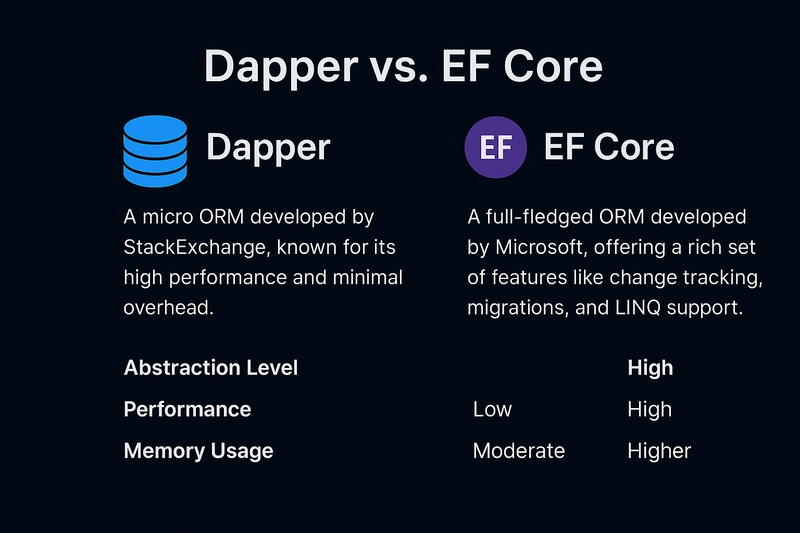🔍 Introduction
In the .NET ecosystem, two prominent data access technologies are Dapper and Entity Framework Core (EF Core). Both have evolved significantly, especially with the advancements in .NET 8 and 10. Understanding their performance characteristics is crucial for developers aiming to make informed decisions.
⚙️ Framework Overview
Dapper: A micro ORM developed by StackExchange, known for its high performance and minimal overhead. It provides developers with direct control over SQL queries, making it ideal for scenarios where performance is critical.
EF Core: A full-fledged ORM developed by Microsoft, offering a rich set of features like change tracking, migrations, and LINQ support. While it introduces some performance overhead due to its abstractions, it enhances developer productivity.
⚡ Performance Benchmarks
Recent benchmarks highlight the performance differences between Dapper and EF Core:
Insert Operations: Dapper outperforms EF Core by approximately 65 times in insert operations. This is primarily due to EF Core’s change tracking and additional abstractions.
DEV Community
Single Record Updates: Dapper executes updates faster, averaging 169.2 microseconds, compared to EF Core’s 209.1 microseconds. Additionally, EF Core consumes about 16.67 times more memory due to its internal mechanisms.
Trailhead Technology Partners
Bulk Operations: For bulk inserts, Dapper demonstrates superior scalability. While EF Core is marginally faster for smaller datasets, Dapper maintains consistent performance as the dataset size grows.
Trailhead Technology Partners
🧠 Memory Usage
Memory consumption is a critical factor in performance:
Single Insert: Dapper uses approximately 18.23 KB, whereas EF Core uses about 39.09 KB.
Bulk Insert (30 records): Dapper uses around 427.73 KB, while EF Core uses approximately 753.61 KB.
These figures underscore Dapper’s efficiency in memory management.
Trailhead Technology Partners
🛠️ Feature Comparison
| Feature | Dapper | EF Core |
|---|---|---|
| Abstraction Level | Low | High |
| Performance | High | Moderate |
| Memory Usage | Low | Higher |
| Ease of Use | Requires SQL knowledge | LINQ support, migrations |
| Change Tracking | No | Yes |
| Migrations | No | Yes |
| Ideal Use Case | High-performance scenarios | Complex data models, enterprise |
🧩 When to Use Which?
Choose Dapper: For applications requiring high performance, minimal overhead, and fine-grained control over SQL queries. It’s particularly suitable for microservices, high-load applications, and scenarios where raw SQL execution is paramount.
Choose EF Core: For applications with complex data models, where features like change tracking, migrations, and LINQ support are beneficial. It’s ideal for enterprise-level applications where developer productivity and maintainability are priorities.
🧪 Hybrid Approach: Best of Both Worlds
In many real-world scenarios, a hybrid approach can be advantageous:
Use EF Core: For standard CRUD operations, data modeling, and scenarios where its features enhance productivity.
Use Dapper: For performance-critical queries, bulk operations, and scenarios requiring optimized SQL execution.
By leveraging both frameworks appropriately, developers can achieve a balance between performance and productivity.
DEV Community
🏁 Conclusion
Both Dapper and EF Core have their strengths and are suitable for different use cases. Dapper excels in performance and control, making it ideal for high-performance scenarios. EF Core offers a rich set of features that enhance developer productivity, making it suitable for complex applications. The choice between the two should be guided by the specific requirements of your project.




